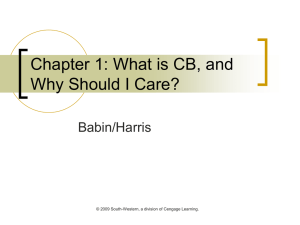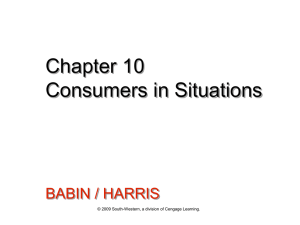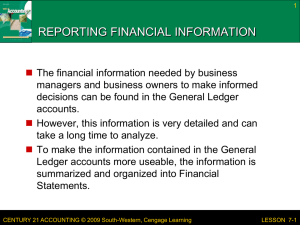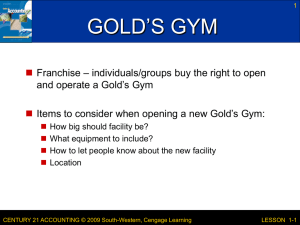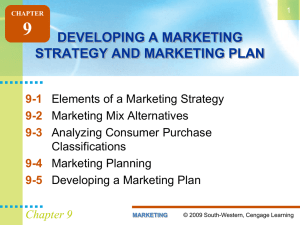Chapter 6
advertisement
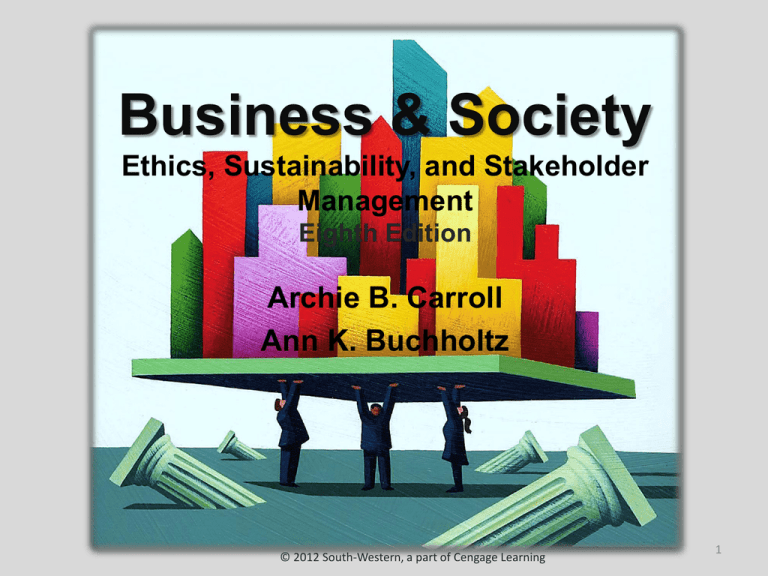
Business & Society Ethics, Sustainability, and Stakeholder Management Eighth Edition Archie B. Carroll Ann K. Buchholtz © 2012 South-Western, a part of Cengage Learning 1 Chapter 6 Issues and Crisis Management © 2012 South-Western, a part of Cengage Learning 2 Learning Outcomes 1. Distinguish between the conventional and strategic approaches to issues management. 2. Identify and briefly explain the stages in the issues management process. 3. Describe the major components in the issues development process and factors in actual practice. 4. Define a crisis and identify the four crisis stages. 5. List and discuss the major stages or steps involved in managing business crises. © 2012 South-Western, a part of Cengage Learning 3 Chapter Outline • The Relationship Between Issues Management and Crisis Management • Issues Management • Crisis Management • Summary © 2012 South-Western, a part of Cengage Learning 4 Issues Management and Crisis Management • The business environment is turbulent and stakeholders are sensitive to emerging issues. • Some firms have not thought seriously about public policy and ethical issues. • Can be impossible to separate the two– the “Siamese twins of public relations.” • Well-conducted issues management can help avoid crises. © 2012 South-Western, a part of Cengage Learning 5 Issues Management A process by which organizations identify issues in the stakeholder environment, analyze and prioritize those issues in terms of their relevance to the organization, plan responses to the issues, and then evaluate and monitor the results. © 2012 South-Western, a part of Cengage Learning 6 Issues Management: Conventional Approach Conventional Approach • Narrowly focused. • Issues fall within the domain of public policy or public affairs management. • Issues have a public policy/public affairs orientation. • Any trend, event, controversy, or public development that might affect the corporation. • Issues originate in social, political, regulatory, or judicial environments. © 2012 South-Western, a part of Cengage Learning 7 Issues Management: Strategic Management Approach Strategic Management Approach • Broadly inclusive. • Is typically the responsibility of senior line management or strategic management staff. • Issues identification is more important than it is in the conventional approach. • Issues management is seen as an approach to the anticipation and management of external/internal challenges to the company strategies, plans, and assumptions. © 2012 South-Western, a part of Cengage Learning 8 Strategic Issue Management © 2012 South-Western, a part of Cengage Learning 9 Issues Issue • A matter that is in dispute between parties. • The dispute evokes debate, controversy, or differences of opinion. The “portfolio approach” of issues management helps firms to prioritize and focus resources on the most important issues. © 2012 South-Western, a part of Cengage Learning 10 Emerging Issues Characteristics of an emerging issue Terms of the debate are not clearly defined Issue deals with matters of conflicting values and interest Automatic resolution is not available Issue is often stated in value-laden terms Trade-offs are inherent © 2012 South-Western, a part of Cengage Learning 11 Issues Management Process Basic Assumptions • Issues can be identified earlier, more completely, and more reliably. • Early anticipation: • Widens the range of options. • Permits study and understanding of the full range of issues. • Permits organization to develop a positive orientation towards the issues. • Organization will have earlier identification of the stakeholders. • Organization will be able to supply information to influential publics earlier and more positively, creating better understanding. © 2012 South-Western, a part of Cengage Learning 12 Model of Issues Management Process Identification of Issues Analysis of Issues Prioritization of Issues Formulation of Issue Responses Implementation of Issue Responses Evaluation, Monitoring, and Control of Results © 2012 South-Western, a part of Cengage Learning 13 Identification of Issues Scan the environment Identify emerging issues and trends © 2012 South-Western, a part of Cengage Learning 14 Identification of Issues (continued) Leading forces as predictors of social change • Events • Authorities/advocates • Literature • Organizations • Political jurisdictions © 2012 South-Western, a part of Cengage Learning 15 Identification of Issues (continued) © 2012 South-Western, a part of Cengage Learning 16 Issues Selling and Buying Issues selling • Relates to middle managers exerting upward influence in organizations as they try to attract the attention of top managers. Issues buying • Top managers adopt a more open mind-set for the issues that matter to their subordinates. © 2012 South-Western, a part of Cengage Learning 17 Analysis of Issues • • • • • Who (which stakeholder) is affected by the issue? Who has an interest in the issue? Who is in a position to exert influence? Who has expressed opinions on the issue? Who ought to care about the issue? To help with issue analysis: • • • Who started the ball rolling? (Historical view) Who is now involved? (Contemporary view) Who will get involved? (Future view) © 2012 South-Western, a part of Cengage Learning 18 Ranking or Prioritization of Issues Two essential questions 1. How likely is the issue to affect the organization? 2. How much impact will the issue have? © 2012 South-Western, a part of Cengage Learning 19 Other Issues: Ranking Techniques Polls / Surveys Expert panels Content analysis Delphi Technique Trend extrapolation Scenario building Use of precursor events or bellwethers © 2012 South-Western, a part of Cengage Learning 20 Formulation and Implementation of Response Formulation • The response design process. Implementation • The action design process. Plan clarity Resources needed Top management support Organizational structure Technical competence Timing © 2012 South-Western, a part of Cengage Learning 21 Evaluation, Monitoring, and Control • Companies should continually evaluate the results of their responses to issues. • Includes careful monitoring of stakeholder opinions. Information from this stage helps firms to make adjustments to the process as needed. © 2012 South-Western, a part of Cengage Learning 22 Issues Development Process Issues Development Process • The growth process or life cycle of an issue. • Has five stages: 1. Early 2. Emerging 3. Current 4. Crisis 5. Dormant © 2012 South-Western, a part of Cengage Learning 23 Issues Development Life Cycle Process © 2012 South-Western, a part of Cengage Learning 24 Issues Management in Practice • Issues management covers a range of public relations and management activities. • Companies that adopt issues management processes: Develop better overall reputations Develop better issue-specific reputations Perform better financially Provides a bridge to crisis management. © 2012 South-Western, a part of Cengage Learning 25 Crisis Management To manage a crisis, one first must understand that crises Occur abruptly Cannot always be anticipated May not occur within a specific issue category Good issues management is a form of precrisis planning and can help stave off crises. © 2012 South-Western, a part of Cengage Learning 26 Crisis Management We are in the era of the mega-crisis • Enron, WorldCom, Arthur Andersen, Tyco, and others accused of financial scandals and malfeasance. • Firestone and Ford were implicated in massive tire recalls due to faulty tires. • Bernie Madoff’s Ponzi scheme defrauded thousands of investors out of billions of dollars. © 2012 South-Western, a part of Cengage Learning 27 The Nature of Crises Crisis definitions • An extreme event that may threaten your very existence. At the very least, it causes substantial injuries, deaths, and financial costs, as well as serious damage to your reputation. • An organizational crisis is a low-probability, highimpact event that threatens the viability of the organization and is characterized by ambiguity of cause, effect, and means of resolution, as well as by a belief that decisions must be made swiftly. © 2012 South-Western, a part of Cengage Learning 28 Crisis Management Rules of crisis management: 1. Don’t wait 2. Don’t run from the truth 3. Don’t hide © 2012 South-Western, a part of Cengage Learning 29 Types of Crises Economic Physical Personnel Criminal Information Reputational Natural disasters © 2012 South-Western, a part of Cengage Learning 30 Outcomes of Major Crises Escalated in intensity Subjected to media and government scrutiny Interfered with normal business operations Damaged the companies bottom line Resulted in major power shifts © 2012 South-Western, a part of Cengage Learning 31 Crisis Management: Four Stages Prodromal Crisis Stage Acute Crisis Stage Warning—precursor Symptom —precrisis Point of no return Crisis has occurred Learning Crisis Resolution Stage Patient is well/ whole again Chronic Crisis Stage Lingering on—perhaps indefinitely; period of selfdoubt; self-analysis © 2012 South-Western, a part of Cengage Learning 32 Managing Business Crises Five practical steps in managing crises 1. 2. 3. 4. 5. Identifying areas of vulnerability Developing a plan for dealing with threats Forming crisis teams Simulating crisis drills Learning from experience Effective crisis management requires tailoring a program to a firm’s industry. © 2012 South-Western, a part of Cengage Learning 33 Ten Steps of Crisis Communications 1. 2. 3. 4. 5. 6. 7. 8. 9. 10. Identify crisis communication team Identify key spokespersons Train your spokespersons Establish communications protocols Identify and know the audience Anticipate crises Assess the crisis situation Identify key messages to communicate Decide on communication methods Be prepared to ride out the storm © 2012 South-Western, a part of Cengage Learning 34 Be First, Be Right, Be Credible Be First • Get the message out first to control content and accuracy. Be Right • Say and do the right thing. Be Credible • Be open, honest, and speak with one consistent voice. © 2012 South-Western, a part of Cengage Learning 35 Successful Crisis Management • Being prepared for a crisis helps companies get their acts together and respond more quickly, with less damage. • Beung prepared for one type of crisis provides valuable learning for when other types of crises strike. © 2012 South-Western, a part of Cengage Learning 36 Key Terms • Acute crisis stage • Chronic crisis stage • Conventional approach to issues management • Crisis • Crisis communications • Crisis management • Crisis resolution stage • Crisis teams • Emerging issue • Issue • Issue selling and buying • Issues development process • Issues management • Portfolio approach • Prodromal crisis stage • Strategic approach to issues management © 2012 South-Western, a part of Cengage Learning 37

